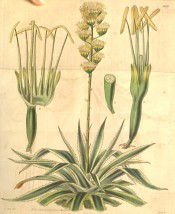Agave americana L. var. marginata
Agave americana L. was first botanically described by Linnaeus in 1853 [Sp. Pl. p.323/1753]. There are a number of variegated forms, with yellow or white leaf margins, e.g. marginata, or yellow or white striped leaves, mediopicta and striata. [RHSE]. Macarthur’s variegata is most likely to be marginata.
Horticultural & Botanical History
Johnson's Dictionary gives the date of introduction of variegata to Britain as 1640. Curtis’s Botanical Magazine figures Agave americana var. foliis variegatus. ‘The Aloe, that Patriarch of the flowers, which “blooms once in a hundred years, and whose blossoms then are developed with such rapidity, as to occasion an explosion resembling the firing of a cannon,” is the theme of a tale that all have heard from their infancy, and to which many still give credence, that is extremely uncertain, and depends much upon the health and vigour of the individuals, and the degree of heat to which they have been exposed. Many live to a great age, and appear never to flower at all. In warm climates twenty-five or thirty years, and, probably, a much shorter period is sufficient to bring them to perfection. The most remarkable instance on record of the early flowering of the American Aloe is that detailed by Mr. Hawkins in the Transactions of the Horticultural Society, v. 4. p. 389. This took place in the open ground, at Woodville, near Salcombe, Devonshire, the residence of the late James Yates, Esq., and considering that the plant is a native of South America, more especially within the tropics, it tells more for the mildness of that part of England, than any circumstance that could be mentioned. The Aloe was planted in 1804, when it was only about six inches high, and then two or three years old, within a few yards of the sea-shore, yet elevated forty or fifty feet above the level of the water, where it never had any cover, shelter, manure, or cultivation. In 1812, it was more than five feet high, and it grew during that summer, nearly the eighth of an inch daily. In 1820 it measured between ten and eleven feet in height, and covered a space, the diameter of which was sixteen feet; its leaves, close to the stem, being nearly nine inches thick. In the beginning of June of that year, a stem made its appearance, resembling a head of Asparagus, of immense size, which, during six weeks grew at the rate of three inches a-day, and then gradually diminished in progress; but not till it had attained the elevation of twenty-seven feet from the ground, which was at about the middle of September. The two lowest branches first showed flowers on the 3d of September, and others came out in succession from the beginning of October to the end of November, when they all began to lose their colour and to decay. There were upwards of forty flowering bunches, each with between three and four hundred flowers, making in all above sixteen thousand blossoms. As the stem grew, the leaves began to wither; and it appears the plant then died. Its age was twenty-one years the height from the earth when in blossom twenty-seven feet: the lateral braches, beginning at twelve feet from the ground, were in number forty-two, the lowest projecting two feet from the stem, and gradually diminishing to about a foot or nine inches in length a the top: the stalk where the side branches commenced was twenty inches round, or nearly seven inches in diameter, gradually tapering to the apex: the bunches of flowers (or at least those next the bottom) were from a foot to fourteen inches in breadth. Although various instances are on record of this plant having blossomed when confined in a pot or tub, and sheltered from the severity of our climate, yet the occurrence is so rare, as to excite a great deal of interest in the neighbourhood where such an event takes place; and I know not whether the variegated-leaved variety, which is not uncommon in collections, blossoms with equal readiness; not having myself heard of the flowering of that kind, till that which is here represented threw up its flowering stem in the summer of 1836, at Aiken Head, the seat of Mrs. Gordon, where, the garden is under the management of Mr. Lambie. In this instance, the whole height of the flower-stalk, was only the half of that of Mr. Yates: and the blossoms were few indeed in comparison; yet they came to great perfection, and the plant made a very noble appearance. But the great size and strange form of this plant, and the rarity of its blossoming in our collections, are not the only circumstances which recommend the American Aloe to attention. It yields a drink, and a fibre of such extensive use in the New World, that it is reckoned, next to the Maize and the Potato, the most valuable of all the products which nature has lavished on the mountain-population of requinoctial America: and no where perhaps is it held in greater esteem than Mexico, according to M. de Humboldt.’ [BM t.3654/1838].
History at Camden Park
Listed in the 1850 and 1857 catalogues [T.38/1850]. Agave americana marginata is common in the Camden Park gardens today and established in the surrounding countryside, particularly along undisturbed roadsides. It seems likely that this is the variegata originally introduced to the gardens.
Notes
Published Feb 22, 2009 - 11:59 AM | Last updated Nov 07, 2011 - 04:23 PM
| Family | Agavaceae |
|---|---|
| Category | |
| Region of origin | Mexico |
| Synonyms | |
| Common Name | Variegated American aloe, Variegated Century plant |
| Name in the Camden Park Record | Agave Americana variegata
|
| Confidence level | high |
